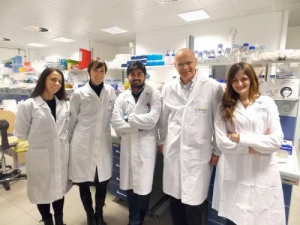A cellular protein which could block the spread of the virus has been discovered, finally solving a 20-year mystery. The study, performed by a research team lead by Massimo Pizzato at CIBIO, University of Trento, has been published in the scientific journal “Nature”.
Thirty five years after the discovery of HIV, neither a definitive cure nor a vaccine exists against the virus which causes AIDS and as yet 39 million deaths worldwide. Research performed by Massimo Pizzato and his team at the Centre for Integrative Biology (CIBIO) at the University of Trento gives rise to new possibilities. The results have been published in the scientific journal “Nature”.
The researchers at CIBIO have discovered the existence of a potent inhibitor of HIV, called SERINC5, which is naturally expressed by the cells. The capacity of HIV to infect new cells strictly depends on its ability to overcome this natural defense, which had until now remained unknown.
 For more than 20 years it has been known that a viral component, called Nef, makes HIV highly infectious. The researchers have now understood that this occurs
For more than 20 years it has been known that a viral component, called Nef, makes HIV highly infectious. The researchers have now understood that this occurs
because Nef allows the virus to overcome the antiviral activity of SERINC5, making HIV more aggressive.
«A cell infected with HIV produces new viruses required to spread the infection within the organism» explains Massimo Pizzato, who has led the research at CIBIO.
«SERINC5 is present on the surface of the cells and is taken up by newly produced viral particles. SERINC5 inhibits these viral particles blocking the ability of the virus to spread the infection. However, in the continuing war with the cells, the virus has taken a further step and for now is winning the battle. Using the viral protein Nef, HIV has acquired the ability to remove SERINC5 from the cell surface and therefore to elude its antiviral activity».
This discovery answers a 20-year scientific mystery within the field of HIV research which, despite extensive efforts by many laboratories worldwide, has remained unresolved. These results suggest new possibilities in the fight against AIDS. «Our discovery exposes an Achilles’ heel of the virus» continues Pizzato. «SERINC5 has an extremely potent activity against HIV. We are now working towards making it “invisible” to HIV to create a defense mechanism that the virus can no longer escape. At that point we will be one step ahead of the virus».
The director at CIBIO, Alessandro Quattrone, comments: «This ground breaking result obtained by Massimo and his team has been made possible by an efficient implementation of new technologies in genome sequencing at CIBIO, which confirms that continuous technological upgrades is the only way to stay at the forefront in biomedical research. After years of investments and efforts the University of Trento is now known worldwide for its research in infectious diseases».
The outcome is the result of a long term work performed by the research team “Virus-Cell interaction” at CIBIO (which in addition to Massimo Pizzato includes his collaborators Annachiara Rosa, Cristiana Cuccurullo, Ajit Chande and Serena Ziglio), with support by the “Laboratory of Biomolecular Sequence and Structure Analysis for Health”, a laboratory shared between CIBIO, the Bruno Kessler Foundation and CNR, and by Federico Santoni at the University of Geneva.
Simultaneously with the study performed at CIBIO the laboratory of Heinrich Gottlinger, at the University of Massachussetts, has independently obtained the same results using a different methodology and therefore reinforcing the outcome and significance of the discovery. The results of both studies have been ublished
independently in the same issue of the scientific journal “Nature”.
The article describing the study performed by the research group at CIBIO, University of Trento, is available: http://dx.doi.org/10.1038/nature15399


